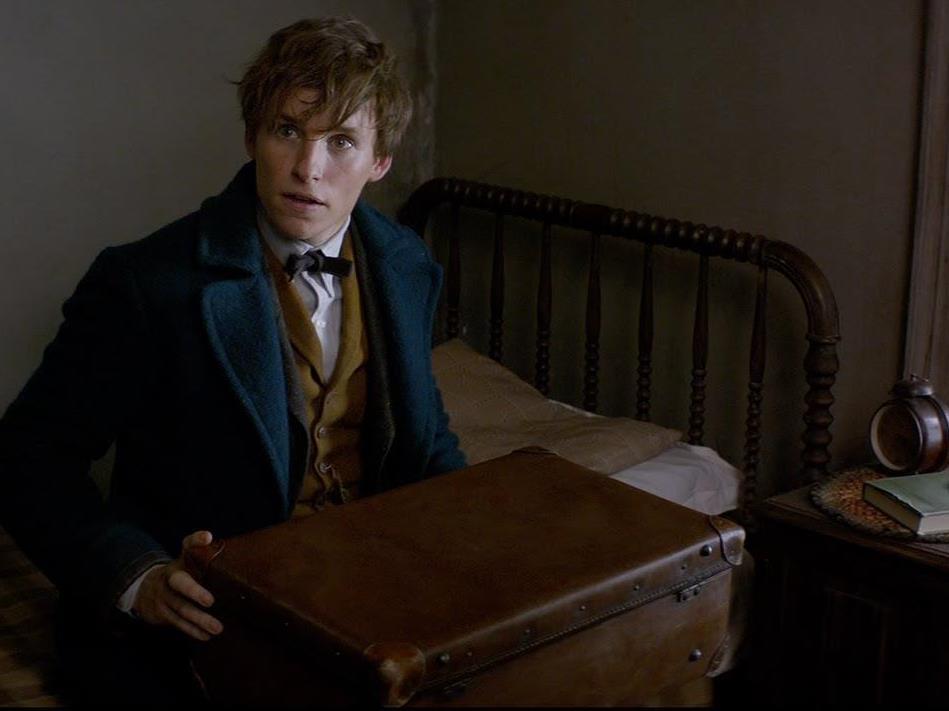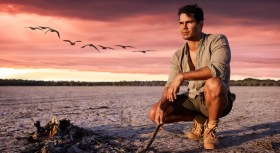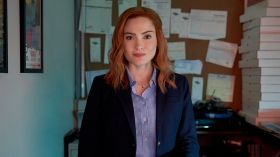Eddie Redmayne as Newt Scamander in Fantastic Beasts and Where to Find Them. Image via Village Roadshow.
Seeking and chasing are well-known terms to the readers of J.K. Rowling’s words, and, when they’re first mentioned early in Fantastic Beasts and Where to Find Them, they’re designed to catch attention, raise a smile and linger in the ear. With the British author writing her first screenplay for the first film spin-off from the seven-book, eight-movie Harry Potter series, she’s nodding to her recognisable wizarding world. In broadening her cinematic footprint with an affectionate wink and a grin, however, she’s also sketching out the foundation for the feature that follows.
Accordingly, as the opening chapter unfurls in what is slated to be a five-part film saga of its own, the movie pursues: new success, escaped magical creatures going where they shouldn’t and a sinister presence that’s threatening relationships between wand-wielding and ordinary folks. And, directed by David Yates (The Legend of Tarzan) who helmed the final four instalments of Hogwarts-set magic antics, it also follows: former glory, a formula designed to set the scene for more to come and characters on an introductory but still enchanted journey.
Opening with the arrival of Newt Scamander (Eddie Redmayne, The Danish Girl) in New York in 1926, Fantastic Beasts and Where to Find Them charts events certain to inform the textbook of the same name – as written by the protagonist within the Harry Potter universe (and by Rowling in reality) then studied by the boy who lived decades later, as fans will know. Scamander is nervous as he presents his suitcase to the authorities for inspection, with its contents containing a cavernous habitat populated by critters of the not-so-ordinary kind. When one trinket-coveting creature scurries into a bank and causes a calamity, he’s suddenly accosted by Magical Congress of the United States of America investigator Tina Goldstein (Katherine Waterston, Steve Jobs). Still, more serious troubles are afoot, not just inspired by No-Maj (aka the US term for muggle) baker Jacob Kowalski’s (Dan Fogler, TV’s Secrets and Lies) interactions with Scamander’s menagerie, but by a mysterious force wreaking havoc across the city.
Dark elements a-brewing, likeable figures thrust into fresh surroundings, new alliances forming, catching them all: if much of Fantastic Beasts and Where to Find Them sounds familiar and feels like dipping a toe into another puddle that’s part of a bigger pond, that’s because evoking such a response is exactly what Rowling and Yates are aiming for. Thankfully, they’re also endeavouring to engage even those that haven’t lived and breathed Harry Potter since the first book was published in 1997, flirt with a slightly bleaker tone and contemplate weighty, timely issues. Scattered around the relationships affectionately forged (including with Other People’s Children’s Alison Sudol as Tina’s mind-reading sister Queenie) and animals understandably marvelled at (spanning the cute, the rampaging and everything in between) is a struggle between positive and negative urges, influences and perceptions, plus a pondering of the tolerance that falls in the middle.
That makes for both a franchise-servicing and world-expanding effort, one that both hews close but with its own tone, and looks for its a way forward within its recognisable template. And, within those confines, it also makes for a film stuffed with information, yet intent on giving its audience something that its characters can’t have: the opportunity not just to dive in, but to catch their breath as they’re immersed in the Fantastic Beasts and Where to Find Them realm. Given that a witch-hunting evangelist (Samantha Morton, The Last Panthers), her tormented adopted son (Ezra Miller, Suicide Squad), and a top wizard auror (Colin Farrell, The Lobster) are intertwined with the storyline as well, that’s crucial. Indeed, even when the movie lags, or proves littered with a few scenes that run a beat or two too long, or is clearly laying groundwork, it remains busy, bustling though never rushed – and allows the cast, notably the kindly-eyed Redmayne, conflicted Waterston, luminous Sudol, eager Fogler, and tantalisingly duplicitous Farrell, to demonstrate depth behind their plot-driven characters.
Also benefiting from the gift of time are the feature’s special effects, its spectacle-heavy images, and its sense of scale and scope, as evident in both big and small moments. Watching the beasts fly, flit, skip and scamper is as eye-catching as it should be, while seeing an evening meal materialise by magic bewitches in just the same manner. Rowling and Yates might be focused on the bigger picture, for the most part – establishing a new series, warming viewers to unknown figures, mirroring yet building – but they haven’t forgotten to hone in on the details. Perhaps that’s why Fantastic Beasts and Where to Find Them demonstrates room for growth and fine-tuning, but achieves the one thing it must: finding the right magic to entertain in its own right, and to keep interest in the next instalment bubbling.
Rating: 3.5 stars out of 5
Fantastic Beasts and Where to Find Them
Director: David Yates
UK | USA, 2016, 133 mins
Release date: November 17
Distributor: Roadshow
Rated: M
Actors:
Director:
Format:
Country:
Release:





